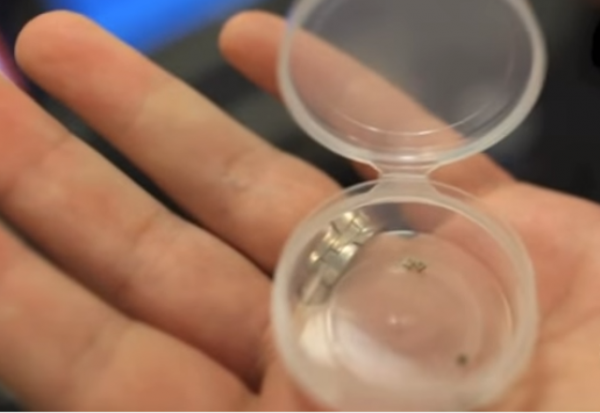World’s Smallest Temperature Sensor Chip PREMIS Powers Itself Using Radio Waves
| Daphne Pianca | | Dec 12, 2015 01:35 AM EST |
(Photo : YouTube Screenshot) Dutch scientists created a tiny temperature sensor chip that powers itself with the use of radio waves that are part of its own wireless network.
Dutch scientists created a tiny temperature sensor chip that powers itself with the use of radio waves that are part of its own wireless network.
Neither a single wire nor a battery that would have to be replaced is required for the sensor. One of the industry's biggest hurdles is making a battery-free sensor. Sensor chips that measure temperature is increasingly popular around cities and in smart homes and offices. The new type of sensor plays a huge role in the future of consumer electronics and the Internet of Things according the researchers at Eindhoven University of Technology.
Like Us on Facebook
The STW technology foundation gave funding to the project PREMISS. "Fully Integrated Ultra-Low Power mm-Wave Wireless Sensor Design Methods" is the thesis title of researcher Hao Gao.
The lead researcher and TU/e professor Peter Baltus of wireless technology mentioned that using similar technology, other sensors measuring data like light and humidity can also be developed. He also said that swapping the batteries all the time is annoying when the user has hundreds of these sensors around our homes.
The sensor's current version has a range of 2.5 centimeters to ultimately 5 meters with the researchers expecting to extend this to a meter within a year. A specially developed router is designed with it. An antenna will send radio waves to the sensors to power the sensor and the router.
The energy transfer is targeted at the sensor, and the router consumes very little electricity. Their energy consumption is extremely low because of the way the sensors are made. The sensor is also capable of working beneath a layer of paint, concrete, or plaster that makes it easy to be incorporated in buildings.
Once there is enough energy stored in the sensor, it will measure the temperature and send signal to the router. This signal has a distinctive frequency that depends on the temperature measured. The sensor is cheap with the cost of an individual chip at around 20 cents.
Tagsworld's smallest temperature sensor chip, PREMIS, battery-free sensor, Hao Gao, Peter Baltus, Radio waves, STW technology foundation, Wireless Technology
©2015 Chinatopix All rights reserved. Do not reproduce without permission
EDITOR'S PICKS
-

Did the Trump administration just announce plans for a trade war with ‘hostile’ China and Russia?
-

US Senate passes Taiwan travel bill slammed by China
-

As Yan Sihong’s family grieves, here are other Chinese students who went missing abroad. Some have never been found
-

Beijing blasts Western critics who ‘smear China’ with the term sharp power
-

China Envoy Seeks to Defuse Tensions With U.S. as a Trade War Brews
-

Singapore's Deputy PM Provides Bitcoin Vote of Confidence Amid China's Blanket Bans
-

China warns investors over risks in overseas virtual currency trading
-

Chinese government most trustworthy: survey
-

Kashima Antlers On Course For Back-To-Back Titles
MOST POPULAR
LATEST NEWS
Zhou Yongkang: China's Former Security Chief Sentenced to Life in Prison

China's former Chief of the Ministry of Public Security, Zhou Yongkang, has been given a life sentence after he was found guilty of abusing his office, bribery and deliberately ... Full Article
TRENDING STORY

China Pork Prices Expected to Stabilize As The Supplies Recover

Elephone P9000 Smartphone is now on Sale on Amazon India

There's a Big Chance Cliffhangers Won't Still Be Resolved When Grey's Anatomy Season 13 Returns

Supreme Court Ruled on Samsung vs Apple Dispute for Patent Infringement

Microsoft Surface Pro 5 Rumors and Release Date: What is the Latest?










